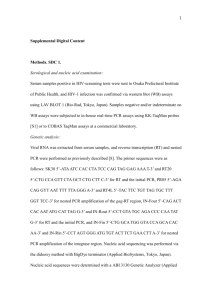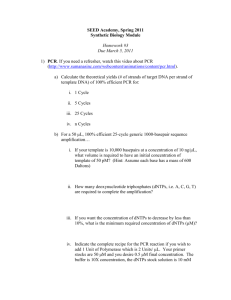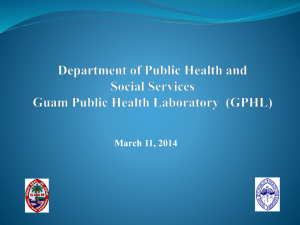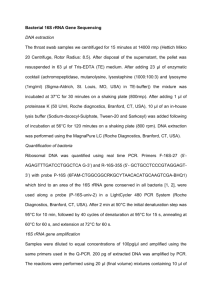REC 024
advertisement
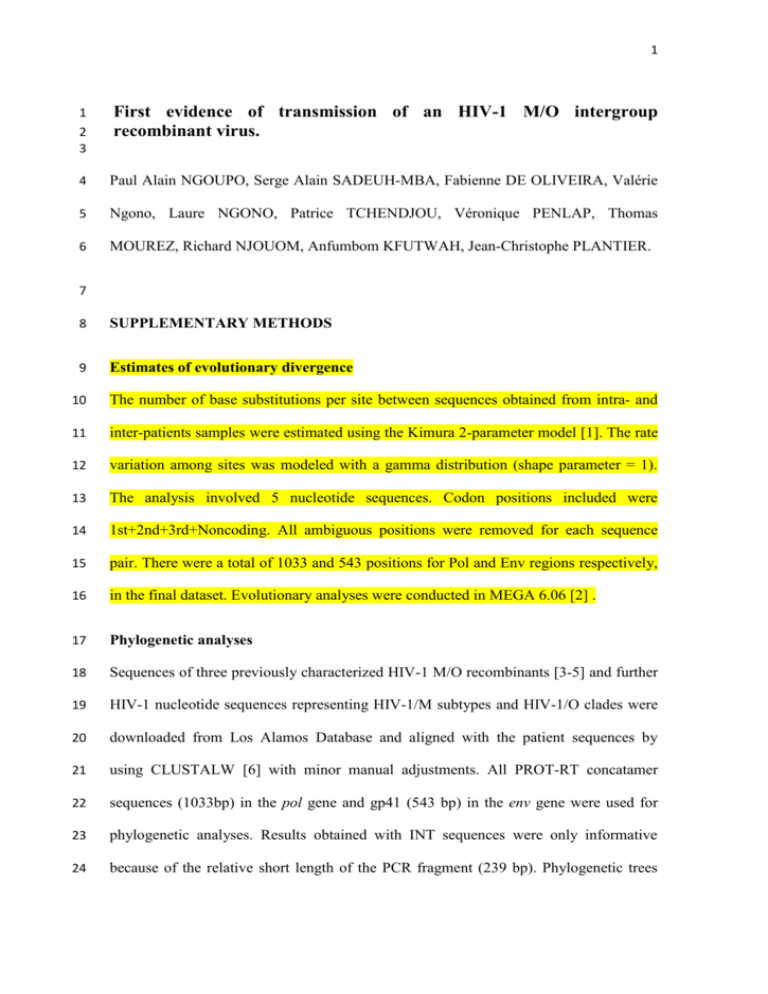
1 1 2 3 First evidence of transmission of an HIV-1 M/O intergroup recombinant virus. 4 Paul Alain NGOUPO, Serge Alain SADEUH-MBA, Fabienne DE OLIVEIRA, Valérie 5 Ngono, Laure NGONO, Patrice TCHENDJOU, Véronique PENLAP, Thomas 6 MOUREZ, Richard NJOUOM, Anfumbom KFUTWAH, Jean-Christophe PLANTIER. 7 8 SUPPLEMENTARY METHODS 9 Estimates of evolutionary divergence 10 The number of base substitutions per site between sequences obtained from intra- and 11 inter-patients samples were estimated using the Kimura 2-parameter model [1]. The rate 12 variation among sites was modeled with a gamma distribution (shape parameter = 1). 13 The analysis involved 5 nucleotide sequences. Codon positions included were 14 1st+2nd+3rd+Noncoding. All ambiguous positions were removed for each sequence 15 pair. There were a total of 1033 and 543 positions for Pol and Env regions respectively, 16 in the final dataset. Evolutionary analyses were conducted in MEGA 6.06 [2] . 17 Phylogenetic analyses 18 Sequences of three previously characterized HIV-1 M/O recombinants [3-5] and further 19 HIV-1 nucleotide sequences representing HIV-1/M subtypes and HIV-1/O clades were 20 downloaded from Los Alamos Database and aligned with the patient sequences by 21 using CLUSTALW [6] with minor manual adjustments. All PROT-RT concatamer 22 sequences (1033bp) in the pol gene and gp41 (543 bp) in the env gene were used for 23 phylogenetic analyses. Results obtained with INT sequences were only informative 24 because of the relative short length of the PCR fragment (239 bp). Phylogenetic trees 2 25 were reconstructed in MEGA 6.06 software[2] by the neighbor-joining method with the 26 Kimura two-parameter method for computing evolutionary distances [1]. All alignment 27 gaps were removed from the analysis for each sequence pair. The reliability of the tree 28 topologies was estimated by bootstrap analysis with 1,000 pseudo-replicate data sets. 29 Near–full length genomes characterization 30 Near–full length genomes of sample of October 2012 from REC003 and sample of 31 March 2013 from REC024 were amplified using a strategy of amplification of 7 32 overlapping fragments (supp figure 2) as follows: 33 RNA was extracted from 200 µL of plasma sample. RT-PCR was performed using 34 SuperScript™ III One-Step RT-PCR System with Platinum® Taq High Fidelity 35 (Invitrogen) in a final volume of 50 µL containing 20 pmol of each primer (supp table 36 1), 2 mM MgSO4 and 10 µL of RNA extract. We used a Perkin Elmer Gene Amp PCR 37 System 9700 with the following cycling conditions: 50 °C for 30 min, 94 °C for 2 min, 38 followed by 35 cycles of (94°C for 15 s, 55°C for 30 s, and 68 °C for 2min30s) and a 39 final extension of 68°C for 10 min. 2 µL of RT-PCR products were then subjected to 40 nested PCR reaction with HotStarTaq Master Mix (Qiagen) in a final volume of 50 µL 41 containing 20 pmol of each primer (supp table 1) and 1.5 mM MgCl2. The cycling 42 conditions consisted of 95°C for 15 min followed by 35 cycles (94 °C for 30 s, 50 °C 43 for 30 s, and 72 °C for 2 min) and a final extension step of 72°C for 10 min. 44 PCR amplicons were purified with the NucleoSpin Gel and PCR Clean-up (Macherey- 45 Nagel, Düren, Germany) and subjected to sequencing with the CEQ Dye Terminator 46 Cycle Sequencing with Quick Start kit (Beckman).HIV sequence BLAST search were 47 performed 48 (http://www.hiv.lanl.gov/content/sequence/BASIC_BLAST/basic_blast.html) from the LANL database and 3 49 Genotyping Retrovirus Tool from the National Center for Biotechnology Information 50 (http://www.ncbi.nlm.nih.gov/retroviruses/). Sequences of overlapping fragments were 51 aligned and assembled using MEGA 6.06 software. 52 Supplementary table 1: Primers used for near-full length genome characterization of the 53 recombinant forms. Genome region LTR-Gag Step RT PCR NESTED RT PCR NESTED Gag-Pol RT PCR NESTED RT PCR NESTED Pol RT PCR NESTED RT PCR Pol-Accessory genes-Env NESTED RT PCR NESTED Accessory genesEnv RT PCR NESTED RT PCR Env NESTED Primers LTRM514U25 (U) G01 (L) LTRO152 (U) UNIL1 (L) POLM2610U25 (U) UNIL2 (L) MW1 (U) RT20 (L) UNIU1 (U) RTO1L (L) PROT1 (U) UNIL2 (L) RTOXL1U (U) POLU2 (L) RTO1U (U) INTO3L (L) RTOXL1U (U) POLORB (L) RTO1U (U) POLU2 (L) VIF1 (U) VPU1 (L) POLM4920 (U) ENVO6L (L) ENVO6338U23 (U) ENVO7402 (L) ENVO7U ND2 (U) V3DURR (L) REVO6U (U) UNIL5 (L) ENVO7U (U) UNIL3 (L) V3DURA (U) GP41NE 3’(L) GP41NE 5’(U) 54 55 56 Fragment size (bp) 1768 1747 1174 466 1755 1750 1735 1594 1727 1650 1542 1521 1090 1078 1918 1254 1698 749 Supplementary table 1 (continued) RT PCR Env-LTR Primer sequence (5’---------- 3’) GCAAGCTTTATTGAGSSTTAAGCAG AGGGGTCGTTGCCAAAGA CTCAATAAAGCTTGCCTTGA CCAAAGAGKGATYTGAGGG GTTAAACARTGGCCATTRACAGARG GAATCCAGGTRGCYTGCC CCACARGGATGGAAAGGATCACC CTGCCAGTTCTAGCTCTGCTTC GGAAATGTGGAMAGGAAGG AATTCCCATTCWGGAATCCA TAATTTTTTAGGGAAGATCTGGCCTTCC GAATCCAGGTRGCYTGCC CTCCAYCCAGACAARTGGAC GTATTACTACTGCCCCTTCACCTTTCCA GAAARCTAAATTGGGCAAGTC GGGTCTCTGCTRTCTCTGTAATA CTCCAYCCAGACAARTGGAC ACTGCHCCTTCHCCTTTCCA GAAARCTAAATTGGGCAAGTC GTATTACTACTGCCCCTTCACCTTTCCA GGGTTTATTACAGGGACAGCAGAG GGTTGGGGTCTGTGGGTACACAGG AGAGAYCCWATTTGGAAAGGACC TTGTGMTGCCCAAATATTATG GGCTTTGMTAAYCCCATGTTTGA TGTGTTACAATARAAGAAYTCTCCAT TTTGMTAATCCCATGTTTGA AAAGAATTCTCCATGACAGTTAAA ATCTCCYATGGCAGGAAGAAG YTGCTGTTGCACTATRCC TTTGMTAAYCCCATGTTTGA CCCATAGTGCTTCCTGCTGC ATTCCAATACACTATTGTGCTCCA TAAGTTGCTCAAGAGGTGGTA TAAGTGCAGCAGGTAGCACTAT NESTED GP41NE3’ (L) GP41NE 5’(U) LTROL (L) GP41OXL (U) LTRM514L25 (L) TAAGTTGCTCAAGAGGTGGTA TAAGTGCAGCAGGTAGCACTAT TCAAGGCAAGCTTTATTGAG AACATTAGGCAGGGATATCAAC GCAAGCTTTATTGAGSSTTAAGCAG 1922 1354 4 57 Supplementary table 2. Genetic distances (intra- and inter-patients) between Pol and 58 Env sequences obtained from the sequential samples of REC003 and REC024. 59 Pol region REC003 10/2012 REC003 REC003 REC003 REC024 REC024 10/2012 03/2013 09/2013 03/2013 09/2013 - REC003 03/2013 0,004 REC003 09/2013 0,011 0,010 REC024 03/2013 0,037 0,036 0,039 REC024 09/2013 0,033 0,033 0,035 Envregion REC003 10/2012 0,003 - REC003 REC003 REC003 REC024 REC024 10/2012 03/2013 09/2013 03/2013 09/2013 - REC003 03/2013 0,008 REC003 09/2013 0,004 0,006 REC024 03/2013 0,071 0,072 0,033 REC024 09/2013 0,063 0,066 0,034 0,020 - 60 61 62 63 64 Supplementary figure 1: Algorithm used to detect dual HIV-1 M+O infections and HIV1 M/O recombinant forms at CPC laboratory 5 65 66 67 Supplementary figure 2: PCR strategy for near-full length genome amplification 68 69 70 71 72 73 74 Supplementary references 6 75 1. Kimura M. A simple method for estimating evolutionary rates of base substitutions 76 through comparative studies of nucleotide sequences. J Mol Evol. 1980 77 Dec;16(2):111-20. 1980. 78 2. 79 80 Tamura K, Stecher G, Peterson D, Filipski A, Kumar S. MEGA6: Molecular Evolutionary Genetics Analysis version 6.0. Mol Biol Evol 2013; 30:2725-2729. 3. Vessiere A, Leoz M, Brodard V, Strady C, Lemee V, Depatureaux A, et al. First 81 evidence of a HIV-1 M/O recombinant form circulating outside Cameroon. AIDS 82 2010; 24:1079-1082. 83 4. Yamaguchi J, Bodelle P, Vallari AS, Coffey R, McArthur CP, Schochetman G, et al. 84 HIV infections in northwestern Cameroon: identification of HIV type 1 group O and 85 dual HIV type 1 group M and group O infections. AIDS Res Hum Retroviruses 86 2004;20:944-957. 87 5. Peeters M, Liegeois F, Torimiro N, Bourgeois A, Mpoudi E, Vergne L, et 88 al.Characterization of a highly replicative intergroup M/O human immunodeficiency 89 virus type 1 recombinant isolated from a Cameroonian patient. J Virol 1999;73:7368- 90 7375. 91 6. Thompson JD, Higgins DG, Gibson TJ. CLUSTAL W: improving the sensitivity of 92 progressive multiple sequence alignment through sequence weighting, position- 93 specific gap penalties and weight matrix choice. Nucleic Acids Res 1994;22:4673- 94 4680.
